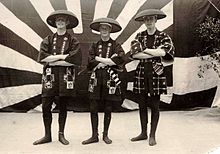Happi
This articleneeds additional citations forverification.(December 2009) |


Ahappi(Pháp bị / bán bị)is a traditional tube-sleevedJapanesecoat,usually worn only duringfestivals.Happitypically feature symbols and/or text on the lapels, with a larger design on the back of the coat, typically the name or the festival or the participating association; thekanjifor ('festival'(Tế り,matsuri)) may also be present.
Originally worn for display of themon,or family emblem,happiwere worn byhouse servantsas a uniform.Firefightersalso worehappicoats, with the crest on the back of the coat displaying the group with which they were associated;[1]these were distinct from thehikeshi sashiko banten(lit. 'embroidered fireman's jacket') also worn by firefighters, constructed from heavily-quilted cotton layers designed to hold a large quantity of water and thus protect the wearer. In theEdo period,firefighters were paid not only for actual firefighting activity but also for promptness and presence at the scene of a fire. Thus, wearing conspicuoushappiand dancing on intact roofs near fires withmatoiwas essential for them.[citation needed]
In English, the termhappiis most often translated as "happi coat" or "happy coat".Happiare typically blue, with designs in red, black, and white, though variations with a number of different colours are also seen in modern day Japan. Modernhappicoats may be made ofcottonorpolyesterfabrics.
References[edit]
- ^Drazen, Patrick.Anime explosion!: the what? why? & wow! of Japanese animation.Stone Bridge Press, 2003.ISBN1-880656-72-8.Page 322."In time, these groups of fire-fighters, adopting uniforms consisting of the short jackets calledhappiemblazoned with themon(crest) of the particular group, so that one gang could be distinguished from another. "

